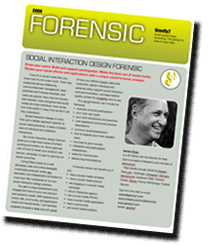Influence has been the most popular way of differentiating people on twitter. In its simplest form, influence is just popularity, as measured by total number of followers. But we know that doesn't really say much. It's a kind of "circulation" model, akin perhaps to circ numbers in the print world, or viewers and listeners in tv and radio. Not very sophisticated, we have to admit, and far less than what interactive media can offer. That said, influence as popularity is, well, a popular metric.
So let's try to break this down a little.
For starters, a few observations. Influence is not absolute, but is relative. Power is not absolute, it is relative. And sociologically speaking, influence can be understood as a form of power. There are different kinds of influence.
Some types of influence:
Social influence, as rank or position within a community: the community may be defined as everyone, or a subset of everyone. Some influence metrics for twitter, such as Twitalyzer, measure one's influence against the entire twitter community. Others, like Klout, must lop off the celebrities (with 250k followers, they are outliers and skew results dramatically) and provide a more meaningful influence score. A simple rank of one's position among all twitter users strikes me as meaningless. (Although it must be fun for those at the top.)
Local influence, as rank within a social group or local community: It makes more sense to measure influence within a circumscribed group of people. The question then becomes "which group?" One answer might be: whatever group we can observe and measure. But let's not limit ourselves to what we can observe and measure today. Let's instead consider some different ways of qualifying influence theoretically:
Influence among followers, those a person follows and those who follow, differentiated by reciprocated and non-reciprocated follow relationships. (Note that without going into details, there is a high degree of distortion here, and dirt in the data, for some people deliberately ignore, say using Tweepler, and some ignore inattentively and coincidentally, and some ignore accidentally. A lot is missed on twitter, and not all people manage followers in the same way.
Influence among an affiliative group, the types of affiliation ranging from industry to social or cultural topic and context, profession, place, and so on. This is difficult to determine today, but over time can be extracted using hashtagged tweets, linguistic markers (words, topics, people names, event names, industry terms and so on), retweets (who is retweeted, what associative affiliation does it suggest), @replies (ditto), and twitter profiles. Scraping other social network profiles will help to qualify this. Here, Peoplebrowsr strkes me as a strong contender but one which, if it catches, will change user behavior also.
Influence as social capital, which might seem like social rank but involves more of the person's actual and perceived social capital. What do I mean by this? There's a well-known distortion in the follower influence/rank model on twitter: people increase their own influence by following the highest-ranked people on twitter. The crude version of following, in which a person follows popular people, probably involves associative social ranking.
By association oneself with a celebrity, influence travels back to the fan (in their minds, of course, but this doesn't matter if a lot of people perceive it). It is an act of following that involves mimetic desire perhaps, and is both strategic and indirect: the person who follows john mayer, with nearly 400,000 followers, is possibly benefiting from John Mayer's huge social rank.
As I understand it, social capital is more than simple popularity, is more than numerical or quantitative popularity, but is a qualified popularity. John Mayer, who follows 19 people, cannot have conversations with his followers. His fans are listening to him, but he's talking at them, not with them. Social capital seems to me a measure of influence in conversational media, and thus involves the expenditure of social capital through conversation and social interactions. It is more than perceived value of capital (John Mayer). it is transactional capital. Because the currency of social media is attention, social capital involves a unique kind of influence: it increases as it is spent, and spending it costs nothing. Social capital involves relationships, and increases with reciprocity. It is engaged and participatory, both of which suit the online medium more than they do the broadcast medium.
One question to come out of social capital as influence is whether or not it is transferable. Does it belong to the person, or can it be extended to what the person talks about? Can it be transferred from a person to a role or position? Do people with lots of social capital transfer it to companies or brands they might represent? Because so much of social capital is built on authenticity and integrity, I think these are as-yet unanswered questions.
.....
Moving on then, there is more to say about influence. There are influential practices. Strategies of accruing influence (macro level influence) and tactics for maintaining, spending, and exercising it (micro, or tweets and "conversations" themselves). Influence in conversation, for example, is an interesting one. Who do we trust? Who do we believe? And for what? I'd like to make a couple points about strategic influence before raising some hairy questions about tactics.
Nietzsche, the philosopher of power and force, taught us that there are two kinds of power: power projected and power attracted. It's bi-directional. Similarly on twitter, there is influence projected and extended, and influence attracted. Jean Baudrillard got himself in trouble with feminism with a book called Seduction in which he described the projected force as male, and the seductive force as female. Without getting into a discourse on the politics of power, we can safely say that projective and seductive forces are at play in cultural influence and identity, and are similarly at play on twitter. Twitter is after all real people, and its lack of a clear social field only amplifies some of the strategies and tactics we use to differentiate ourselves from others.
There is plenty more to say on specific strategies and tactics, but I'm seriously running low on time and need to move on quickly to a final set of distinctions.
Personalities on twitter are distinct. Personality distinctions in social media explain differences in how people see themselves, how they see and relate to others, and in how they interact and engage in social activities. Personality types are not the distinctions made by market segmentation, but are psychologically-based insights into how people behave and why, grounded in interests and motives. While personalities can explain what's really going on, however, they complicate the influence metrics that broadly apply to a population at large. That said, influence becomes much more interesting when we view it as something exercised and as a social distinction that motivates participation. Here generalized models of influence fall way short of explaining individual behaviors.
Without getting into details, for a separate post on "How we tweet" will be required, we can highlight a few personality distinctions relevant to qualifying different ways of exercising influence. I have grouped personality types into Self-oriented, Other-oriented, and Relational-oriented types. These correspond to monological, dialogical, and triangulating social behaviors. And to monadic, dyadic, and triadic social organization. Everything social can be built on isolates (one), dyads (pairs), and triads (three). The modes of talk, or in our case tweeting, would be Self-talk (telling, talking at); conversation (beginning with the other person, or replying); and triangulating (mediating a relationship between two other people).
(the following types are mentioned in my personality types presentation)
- A pundit, for example, may exercise influence by building a reputation, following, and in largely talking at that audience
- A buddy may exercise influence by being highly responsive, attentive, and reciprocating
- A critic may exercise influence by aggregating and distributing content that belongs together (impersonally)
- An expert may exercise influence by talking to a topic in which s/he is personally invested in demonstrating expertise
- A harmonizer may exercise influence by becoming involved in small group and social runs on twitter, often event-related
and there are more....
The measurement of influence on twitter is fascinating, especially when we move from quantifiable influence to strategies, tactics, and practices of influence. At this point in twitter's evolution as a social space, we're going to want to map the social field and begin to locate and delineate social distinctions. It's what we do when social spaces first appear and populate. But twitter is a highly individual social media tool, and an understanding of what we do with it, and how we each relate to its social organization, can really only be understood if we involve the psychology of behavior online. And that requires an understanding of how we see ourselves, others, and social activity overall, and will be expressed in the different ways that personal and social influence can be brought into play through the conversation and social action possibilities afforded by unstructured social tools and communities.
Related
Twitter applications and extensions: a list
Note: This blog post belongs to a series on "status culture." The posts examine status updates, facebook activity feeds, news feeds, twitter, microblogging, lifestreaming, and other social media applications and features belonging to conversation media. My approach will be user-centric as always, and tackle usability and social experience issues (human factors, interaction design, interface design) at the heart of social interaction design. But we will also use anthropology, sociology, psychology, communication and media theories. Perhaps even some film theory.
The converational trend in social networking sites and applications suggests that web 2.0 is rapidly developing into a social web that embraces talk (post IM, chat, and email) in front of new kinds of publics and peer groups. User generated content supplied to search engines is increasingly produced conversationally. Social media analytics tools provide PR and social media marketing with means to track and monitor conversations. Brands are interested in joining the conversation feeds, through influencers as well as their own twitter presence.
This changing landscape not only raises interesting issues for developers and applications (such as the many twitter third party apps), but for social practices emerging around them. So we will look also at design principles for conversation-based apps, cultural and social trends, marketing trends, and other examples of new forms of talk online.
These blog posts will vary in tenor, from quick reflections on experiences to more in-depth approaches to design methodology for conversational social media.
Labels: influence, social interaction design, social media metrics, status culture, twitter




Comments: :
blog comments powered by Disqus
<< Home